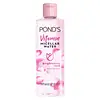Pond's Vitamin Micellar Water Brightening Rose Versus Luxe Organix Whitening Repair Ultra Light Glow Micellar Cleansing Beauty Water
What's inside
What's inside
 Key Ingredients
Key Ingredients

 Benefits
Benefits

 Concerns
Concerns

No concerns
 Ingredients Side-by-side
Ingredients Side-by-side

Water
Skin ConditioningHexylene Glycol
EmulsifyingGlycerin
HumectantNiacinamide
SmoothingRosa Gallica Flower Extract
AstringentRosa Damascena Flower Oil
MaskingSodium Ascorbyl Phosphate
AntioxidantPanthenol
Skin ConditioningRetinyl Propionate
Skin ConditioningPaeonia Lactiflora Root Extract
Skin ConditioningTocopheryl Acetate
AntioxidantHydroxyethyl Urea
HumectantUrea
BufferingPEG-6 Caprylic/Capric Glycerides
EmulsifyingPropylene Glycol
HumectantSodium Chloride
MaskingPotassium Chloride
Parfum
MaskingTrideceth-9
EmulsifyingPEG-40 Hydrogenated Castor Oil
EmulsifyingAmmonium Lactate
BufferingCetrimonium Chloride
AntimicrobialCetylpyridinium Chloride
AntimicrobialCitric Acid
BufferingEthanolamine
BufferingBenzophenone-4
UV AbsorberTetrasodium EDTA
Phenoxyethanol
PreservativeCI 14700
Cosmetic ColorantCI 17200
Cosmetic ColorantWater, Hexylene Glycol, Glycerin, Niacinamide, Rosa Gallica Flower Extract, Rosa Damascena Flower Oil, Sodium Ascorbyl Phosphate, Panthenol, Retinyl Propionate, Paeonia Lactiflora Root Extract, Tocopheryl Acetate, Hydroxyethyl Urea, Urea, PEG-6 Caprylic/Capric Glycerides, Propylene Glycol, Sodium Chloride, Potassium Chloride, Parfum, Trideceth-9, PEG-40 Hydrogenated Castor Oil, Ammonium Lactate, Cetrimonium Chloride, Cetylpyridinium Chloride, Citric Acid, Ethanolamine, Benzophenone-4, Tetrasodium EDTA, Phenoxyethanol, CI 14700, CI 17200
Water
Skin ConditioningPEG-6 Caprylic/Capric Glycerides
EmulsifyingPropanediol
SolventCaprylyl Glycol
EmollientEthylhexylglycerin
Skin ConditioningDisodium EDTA
Niacinamide
SmoothingAscorbic Acid
AntioxidantHydrolyzed Collagen
EmollientBisabolol
MaskingButylene Glycol
Humectant1,2-Hexanediol
Skin ConditioningCentella Asiatica Extract
CleansingAsiaticoside
AntioxidantMadecassic Acid
Skin ConditioningAsiatic Acid
Skin ConditioningMadecassoside
Antioxidant
 Reviews
Reviews

Ingredients Explained
These ingredients are found in both products.
Ingredients higher up in an ingredient list are typically present in a larger amount.
Niacinamide is a multitasking form of vitamin B3 that strengthens the skin barrier, reduces pores and dark spots, regulates oil, and improves signs of aging.
And the best part? It's gentle and well-tolerated by most skin types, including sensitive and reactive skin.
You might have heard of "niacin flush", or the reddening of skin that causes itchiness. Niacinamide has not been found to cause this.
In very rare cases, some individuals may not be able to tolerate niacinamide at all or experience an allergic reaction to it.
If you are experiencing flaking, irritation, and dryness with this ingredient, be sure to double check all your products as this ingredient can be found in all categories of skincare.
When incorporating niacinamide into your routine, look out for concentration amounts. Typically, 5% niacinamide provides benefits such as fading dark spots. However, if you have sensitive skin, it is better to begin with a smaller concentration.
When you apply niacinamide to your skin, your body converts it into nicotinamide adenine dinucleotide (NAD). NAD is an essential coenzyme that is already found in your cells as "fuel" and powers countless biological processes.
In your skin, NAD helps repair cell damage, produce new healthy cells, support collagen production, strengthen the skin barrier, and fight environmental stressors (like UV and pollution).
Our natural NAD levels start to decline with age, leading to slower skin repair, visible aging, and a weaker skin barrier. By providing your skin niacinamide, you're recharging your skin's NAD levels. This leads to stronger, healthier, and younger looking skin.
Another name for vitamin B3 is nicotinamide. This vitamin is water-soluble and our bodies don't store it. We obtain Vitamin B3 from either food or skincare. Meat, fish, wheat, yeast, and leafy greens contain vitamin B3.
The type of niacinamide used in skincare is synthetically created.
Learn more about NiacinamideThis ingredient is derived from caprylic and capric acids. It is an emulsifier with emollient properties.
According to the manufacturer, it is hydrophilic and soluble in aqueous solutions (water). They also state this ingredient is stable in a medium pH range (~5 - 8).
As an emulsifier, it helps make oils and oil-soluble ingredients more soluble in water.
Learn more about PEG-6 Caprylic/Capric GlyceridesWater. It's the most common cosmetic ingredient of all. You'll usually see it at the top of ingredient lists, meaning that it makes up the largest part of the product.
So why is it so popular? Water most often acts as a solvent - this means that it helps dissolve other ingredients into the formulation.
You'll also recognize water as that liquid we all need to stay alive. If you see this, drink a glass of water. Stay hydrated!
Learn more about Water